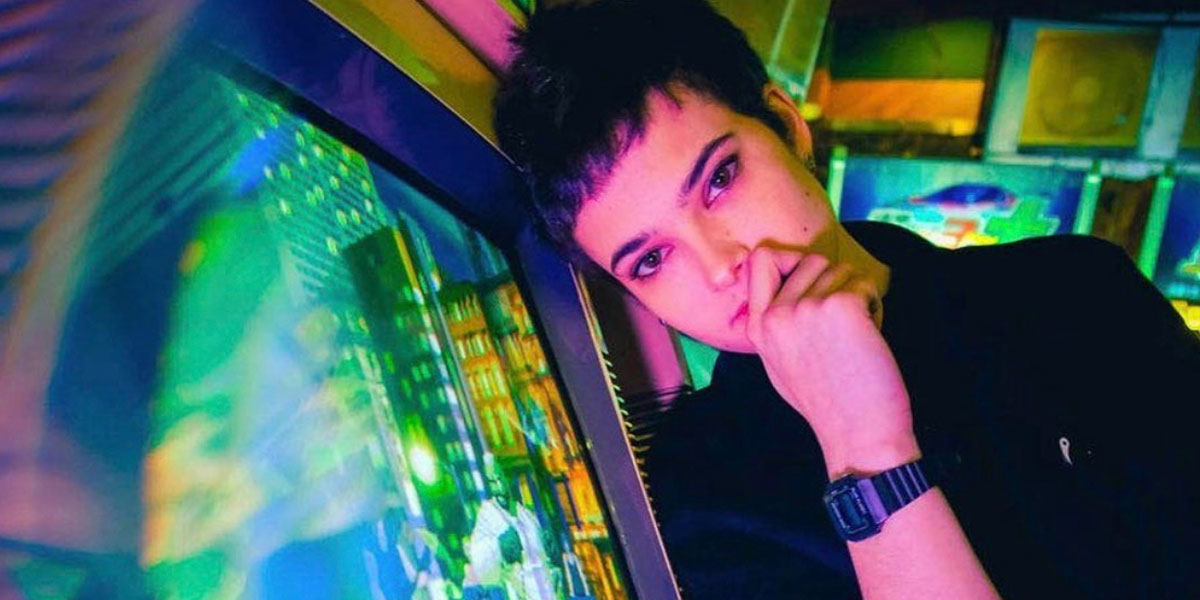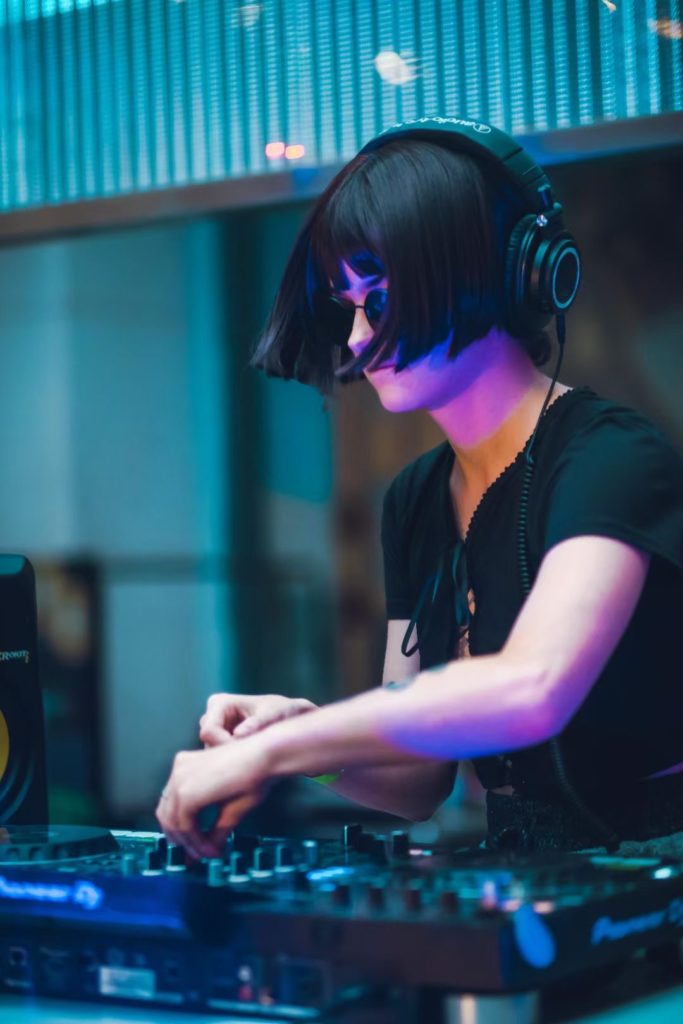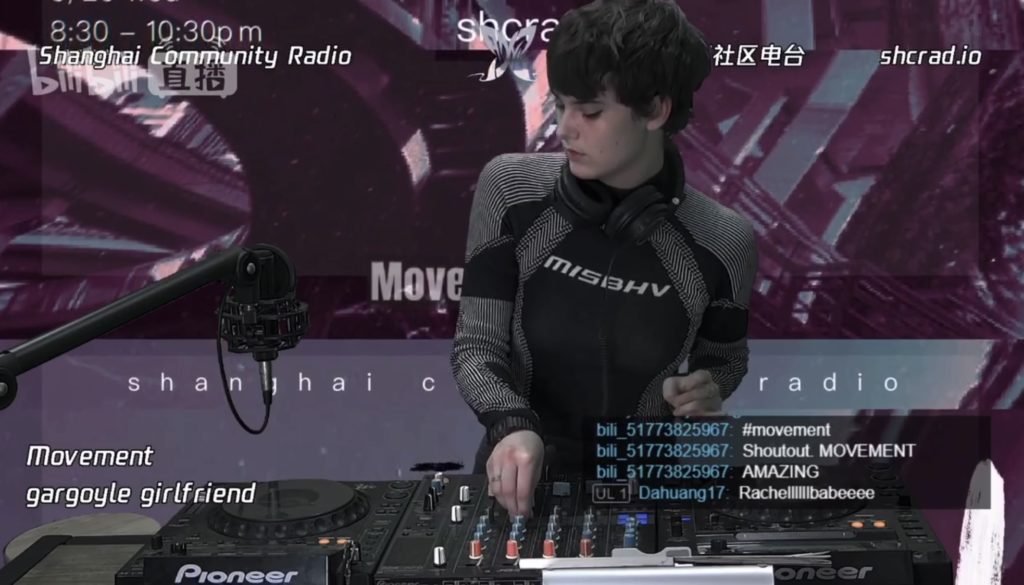
For Rachel McInerney ’18, Illustration, ‘creativity’ means ‘Kaos’ and life as a DJ in Shanghai
Monday, December 13th, 2021
Sometimes, the creative path forward looks like befriending and learning from older, more experienced artists.
Sometimes, it looks like challenging your introverted nature by venturing alone into new settings.
Other times, it may feel like the world opening up when you find a creative niche — say, music — that really moves you.
If you’re Rachel McInerney ’18, it can look like all of the above and more.
The Illustration BFA graduate of PCA&D has turned what started as a gig teaching English in China into a multifaceted creative life that includes not only DJing in Shanghai under the name Gargoyle Girlfriend, but also founding an art collective that hosts live bands, raves, and art shows in a former bomb shelter.
It sounds about as far from Lancaster and her undergrad years as you can get. Yet the New Jersey native says that the seeds planted at PCA&D no doubt form the roots for life as she’s living it: bursting with collaboration, expansive creativity, and an urge to keep exploring and stretching boundaries.

Rachel McInerney, ’18, Illustration, is a DJ in Shanghai using the name Gargoyle Girlfriend. She also founded an art collective called Kaos: Art in the Underground.
The PCA&D years
What were you involved with during your time here at PCA&D?
RM: It really evolved throughout the years, in unexpected ways and adventures. I quickly befriended the older grades when I was a freshman and found in particular that this group of painters was really taking their craft seriously and we all ended up living together… shout-out to Josh Brightbill, Casey Clark, Dave Shmuck. They really looked out for me and challenged me technically in that handful of years. And that bond is really special, and when I play in bands now it feels sort of similar — collaborative, intimate, caring. Since they graduated way before I did, it pushed me to find friends (in the city), and shortly after that, I made friends with people in the local live music scene. It became sort of important to me to separate school life and “nightlife” as it were, so I kinda treated school as all business comparatively — although I’m sure a few professors would say otherwise (laughs).
What were those early experiences like?
RM: Once I turned 21 — which felt like it took forever — I was able to sort of explore the nightlife and I had a thing for doing it by myself. I really enjoyed walking into a space of strangers and the social challenge of that. I’d been sort of introverted all my life and something about that was starting to turn around. When you’re young you have this twisted idea of what a “nightclub” is, right? And with art school you kinda skip that “frat house party” trope. … I wasn’t even sure what I wanted to experience I just… wasn’t even sure what to look for. One night I was just super bored and restless, and saw a Facebook Events post about The Village (nightclub in Lancaster) putting on this Gothy-emo event called “Shadowlands” and I showed up by myself and it was just — wild, and weird, and wonderful. They were remixing Nine Inch Nails and playing fast-paced EBM, like, stuff you can really dance to even though it’s super emo. Everyone head-to-toe in paint or latex or literally whatever, and I met some oddballs and danced literally all night. An older gentleman in skull face paint walked me home because I was small, and I remember after being like, “Clubs can be like that?”
Like I spent all these years getting decent with painting and then suddenly I was back at square one with a creative goal. I remember it being physically painful. It still is whenever I’m trying to improve a skill.
So your interest in this music goes back to your time at PCA&D.
RM: Yeah, I mean, that’s when the switch really went off. I was never really interested in making music in my teen years. My mom signed me up for guitar lessons, but I didn’t really dig it. I always listened to music while I painted and sort of considered it a part of the process, but I never before felt compelled to produce it, like, at all. I guess that’s where it gets interesting because all of a sudden I was trying to make music and I sucked at it. And all these paintings were due, and I was staying up all night on my synthesizer, and it just felt like “starting over.” Like I spent all these years getting decent with painting and then suddenly I was back at square one with a creative goal. I remember it being physically painful. It still is whenever I’m trying to improve a skill.
And then, Shanghai.
So how does one get from Lancaster to China? In McInerney’s case, she says, “it was kind of random. I really didn’t know anything about China, and I kind of thought, ‘If I’m really gonna do this adult thing, I should do it in the most alienating and difficult way possible so that anywhere I go isn’t scary.’ … I landed an interview (teaching in) China and a month later I was already getting sorted to quit my job and fly over.” She’s now been there three years, starting out teaching English and then segueing into an art position.
Who first suggested you try DJing?
RM: Well, once I moved to Shanghai, where there is some hyper-future laser nightclub on every other street, I got really quickly embedded in the culture. It started with punk bands and helping them design gig posters and stuff, and eventually, I was singing with them… I had a panic attack before my first show; I almost didn’t make it out of my apartment. But I did, and I spent the year touring China with them and organizing shows. And then quarantine happened, and my own band formed, which has more techno elements… so I was going out to clubs more to study percussion. It was another DJ from London who asked me if I’d team up with him for events. He gave me a few lessons and then made me headline New Year’s Eve and count in the year on the mic. And that was such a rush when everyone screamed.
Was it immediately exhilarating?
RM: Was I nervous? Extremely … But ever since I moved here I’ve had this philosophy of, like, “If you can pull off mountains of paperwork in Chinese, then you can do anything.” And it was sort of like that. “If you can DJ New Year’s Eve, then you can do anything.” So usually I’m doing the scariest thing possible and trusting the flow with the results.
Professors treated me with a lot of respect, and I never forget that. I try to give the same respect to my high school students.
What did you learn at PCA&D that informs your creativity as a DJ?
RM: Versatility? Reading the room? I always struggled with having a “style” or a “palette” and I liked cartooning just as much as I liked photorealism. So it’s always made me nervous that I’m interested in absolutely everything. … I definitely embrace graphic design and marketing for the scene, too, more than I thought I did at the time. Also, professors treated me with a lot of respect, and I never forget that. I try to give the same respect to my high school students.
You also pursue collaborative projects … What does that fulfill for you that working solo does not?
RM: Man, it’s wild because I really was set in my ways as an independent creator, you know? Painting can be reallllly lonely and in that way, I loved living with other artists. But your piece is always your own. Now, with my band, it belongs to all of us — we carry it on stage so it can live, but it needs all of us. And I don’t know musical terminology at all, so I’m in a room with men who have been making music their whole life, and I’m like, “Nah, what if you use the cousin of that chord?” And they look at me and they know what I mean. And they don’t even make me feel bad about it, because they are the best. When I feel incompetent, they point out where a lot of the ideas are coming from. And it’s coming from this vague place of just wanting to create — technical skill or not. But I have learned at record speed for their patience and coolness — and it helps they are also teachers (laughs).
Working in ‘Kaos’
Once the pandemic eased and nightlife began to get back to normal in Shanghai, McInerney’s creativity took another turn: She started an art collective called Kaos: Art in the Underground. Housed in a massive, graffiti’d bar that used to be a bomb shelter, Kaos hosts art shows, live bands, and raves. “The staff treats me like family and we really turned the place into this other energy,” McInerney says, “so I’m really proud of that.”
McInerney quotes a recent magazine article, which calls Kaos “one of the coolest monthly creative events in Shanghai … Expect a fusion of local music with art, zines, poetry, fashion, tattoos, and everything DIY. You can see art, buy art and even make art with your fellow Shanghai subcultures, or just rave the night away.” The free event, she says, “was listed this year as one of the best things to do under 25 RMB (renminbi, the official Chinese currency) — because I’ve always been adamant about it being ticketless. I remember being a poor student all too well.”
How has the change of scenery and scene, so to speak, influenced your creativity? Did it spark something new in you?
RM: Sort of unrelated, but I’ll never forget the first time I dreamt in Chinese characters — so weird! I think definitely I take in a lot around me at a subconscious level. Shanghai feels like the sci-fi future compared to the U.S. I can afford living expenses quite easily, and any supplies all the time, so that’s also a huge help, and a big change … It’s also really interesting when you don’t speak the language. I remember I flew back home for a week and being able to hear and understand everyone’s conversations around me at the airport really overwhelmed me … So I think there’s something to be said about walking around oblivious to what other people are saying. I know that sounds kind of ignorant; Mandarin takes a lot of focus to hear and understand because it’s tonal. I kind of appreciate the solitary auditory state sometimes. So when I go to Thailand and stuff, it’s the same kind of comfort.
Advice for the creative life
What advice would you have for an art student who isn’t sure what direction to go in?
RM: This isn’t — or shouldn’t be — the end of your art career, or the process you envisioned from the start. It’s not about waiting around for a commission or client to come by, or name-dropping the studio you want a seat in. Go out and have fun in this bizarre world. Use your skills to be involved and help people around you, if you can. I learned that the act of “being in service” goes a long way when you feel lost or unsure. Show up by yourself. Bring your friends to new environments. Find the classes, techniques, and professors that speak to you and go with your gut. I studied illustration but elbowed my way into a few Fine Art classes to paint, so really try to carve out what you want out of your experience!
And, lastly, study hard, chill hard. Sunsets are the best from the Lemon Street cemetery, and I think of it often.

